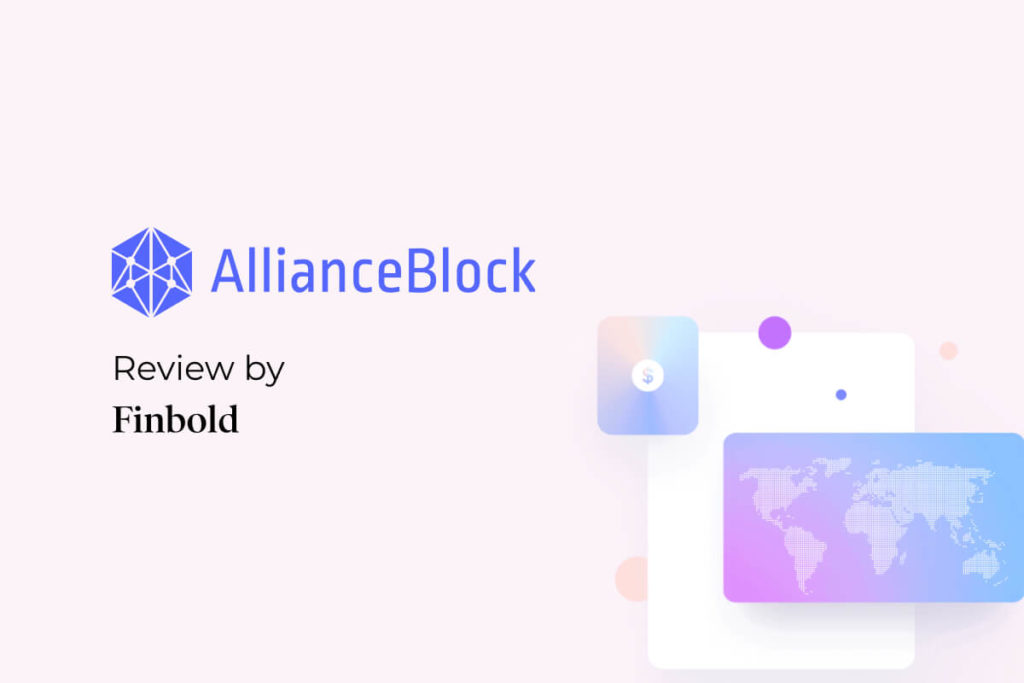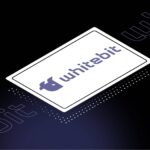This review will look at the AllianceBlock Protocol, a decentralized, blockchain-agnostic layer 2 that seeks to bridge the disparate worlds of traditional (TradFi) and decentralized finance (DeFi). Specifically, we will cover AllianceBlock’s architecture, possible use cases, ecosystem, and the tokenomics of its native utility token, ALBT. The review also delves into the protocol’s security credentials, the team’s customer support channels, its pros and cons, and several other features.
About the AllianceBlock Protocol

The portal represented AllianceBlock’s MVP (minimum viable product), enabling users to participate in crowdfunding efforts, swap tokens, and manage funds and investment portfolios, among several other functionalities.
Since the launch of the MVP, AllianceBlock has grown beyond its MVP proposition to offer a more expanded service listing that comprises the following:
- Trustless KYC/AML;
- DeFi Terminal;
- Trustless Identity Verification;
- The Data Tunnel;
- Compliant peer-to-peer (P2P) funding;
- Cross Border Regulatory Compliance.
- DEX & Bridge.
The protocol aims to bridge the gap between traditional finance, or TradFi, and decentralized finance (DeFi). TradFi refers to the conventional methods of accessing financial instruments such as loans, savings, bonds, capital accumulation, etc., typically involving engaging with a licensed and regulated intermediary such as banks.
DeFi, on the other hand, is the umbrella term used to reference new-age financial access methods that exclude any reliance on intermediaries. These methods are based on the nascent blockchain technology enabling the use of decentralized protocols to offer financial instruments such as yield farming, saving and lending, liquidity provision, and token swaps, among others, while avoiding centralized entities.
Even though DeFi has several benefits, such as offering easy access to global capital and cost friendliness, it does suffer from one major disadvantage – a lack of proper oversight from regulatory agencies. TradFi players operate within strict regulatory provisions, so they are restricted from exploring opportunities within the DeFi ecosystem.
AllianceBlock aims to address this challenge by acting as a bridge enabling centralized institutions and retail investors operating within the TradFi ecosystem to interact with DeFi applications in a regulated environment easily. Similarly, those currently using Defi apps can quickly transfer their capital to and from TradFi entities.
Recommended: Introductory video to the AllianceBlock Protocol
How the AllianceBlock Protocol Works
AllianceBlock has implemented what it calls the Prometheus Protocol to ensure that its platform complies with global financial regulations. Prometheus is a multi-layered architecture that facilitates capital transfer across borders in a legally compliant and regulated manner. As explained earlier, regulations are the missing link required by TradFi entities to engage within the DeFi ecosystem freely.
The Prometheus protocol is made up of three layers which are:
- Data Governance Layer – dictates local data handling policies for ecosystem participants that comply with global data privacy and security provisions such as the GDPR and others;
- Cross Border Regulatory Compliance Layer – this layer makes provisions for transaction handling to conform with various relevant local and international financial laws that depend on the origin of the transaction, its data handlers, and destination;
- Securities Issuance and Lifecycle Management Layer – ecosystem participants, can issue customized tokens on the AllianceBlock platform. This layer dictates the legal provisions for token issuance in line with global and local regulations.
The three Prometheus Protocol layers work in unison with other ecosystem components to ensure that transactions on the AllianceBlock platform are not only compliant but also secure, transparent, and quick.
AllianceBlock Use Cases
So far, AllianceBlock has six use cases identified by the core team. However, this does not mean that these applications are limited. It is possible that, with time, new use cases will be discovered by the community, increasing the value of the ecosystem. The six ways in which the protocol has been applied are:
- Simplification of cross-border activity while ensuring adherence to international legislation;
- Regulating token issuance to ensure compliant with available and applicable regulations;
- Compliant decentralized finance solutions;
- Fund distribution;
- Regulating digitized derivatives;
- Compliant P2P Lending for Institutional Clients.
The AllianceBlock Products & Solutions
The AllianceBlock team has so far developed and released five main products, all geared toward bridging the TradFi and DeFi worlds. These products are:
1. DeFi Terminal
AllianceBlock’s Defi terminal is comprised of two main services:
- Liquidity mining – which is the process by which terminal users lend their tokens to a decentralized exchange, in this case, the AllianceBlock DEX, in return for rewards;
- Staking – which is a process of locking your assets within a smart contract to earn the right to participate in the governance of a network. AllianceBlock uses a version of the Delegated Proof-of-Stake (dPoS) whereby users can delegate their rights to node operators and partake in the reward sharing.

Other than participating in liquidity mining and staking, developers and brands have the option to create campaigns on the platform attracting users to contribute towards the liquidity of a specific brand’s custom token. This ensures that these customized tokens are always available on the AllianceBlock DEX, where other users may purchase or swap them for other assets.
2. Fundrs app
The AllianceBlock Fundrs app is a decentralized crowdsourcing platform enabling capital seekers and providers to collaborate from the early stages of project development. This ensures that the creators get the much-needed financial support as early as possible, and investors get potentially larger returns for their capital by investing in projects in their infancy.

AllianceBlock dubs Fundrs a start-up-as-a-service product enabling the collaboration of participants in areas such as:
- Capital raising;
- Marketing;
- Market research;
- Business operations, etc.
By participating in this ecosystem, business and project startups can increase their chances of succeeding in the marketplace.
3. AllianceBlock DEX
A DEX (decentralized exchange) is a peer-to-peer (P2P) marketplace in which crypto traders interact directly and swap tokens without using an intermediary. The AllianceBlock DEX (ABDEX) is no exception allowing users to not only switch between their tokens but also allow them to earn by providing liquidity.

The AllianceBlock DEX introduces a unique feature that solves the biggest challenge facing DEXes – impermanent loss (IM). In its case, ABDEX developers have employed an in-house built physics-inspired coupling approach to matching two AMM (automated market makers). This way, both AMMs are shielded against the IM risk.
Impermanent Loss is a loss incurred to a liquidity provider or staker in a DeFi app when the value of their tokens falls while they are still locked within a smart contract. Given the high volatility nature of cryptocurrency assets, IM is a real risk that could discourage potential AMMs from providing liquidity.
By solving the IM risk challenge, ABDEX becomes a great alternative to most of the leading DEXes in the marketplace.
Additionally, ABDEX lives up to the AllianceBlock ethos of platform compliance. To do this, it subjects all users to KYC (know your customer) and AML (anti-money laundering) verification measures.
4. AllianceBridge
AllianceBlock launched its decentralized interoperability solution AllianceBridge in July 2021 to unify the fragmented DeFi space. The idea is that dApps on disparate blockchain networks can communicate with one another to achieve various economic goals.
A bridge in the blockchain space works by enabling seamless conversion of native tokens from different decentralized networks. These tokens can then be used within a new environment than they were designed to operate.

So far, the AllianceBridge supports interoperability amongst seven blockchain networks which are:
- Ethereum (ETH);
- BNB Chain (BNB);
- Polygon (MATIC);
- Avalanche (AVAX);
- Arbirtrum (Ethereum Layer 2 blockchain);
- Optimism (Ethereum Layer 2 blockchain);
- Energy Web Chain (EWC).
A recent addition to the AllianceBridge functionality is the support for NFTs (non-fungible tokens), which are assets representing digital ownership hosted on various smart contract-enabled blockchains. Now, the bridge’s users can swap NFTs native to different networks on the platform directly from their crypto wallets.
5. AllianceBlock Data Tunnel

The AllianceBlock’s Data Tunnel product is a solution to a growing problem within the DeFi space. Some of the challenges DeFi participants have regarding data include:
- Inability to monetize the data;
- Segregated datasets held within disparate blockchain networks;
- Unstandardized data sets;
- Lack of control over data usage once it has been exchanged with a participant or entity within the space.
AllianceBlock has opted to offer the Data Tunnel as the solution for this ever-growing problem enabling users to have access to the following features within the product:
- Allowing data publishers to benefit from their data in the primary and secondary marketplace;
- Full support for some of the most common dataset file types, which are XML, CSV, and JSON;
- Data exchange using the native ALBT token to ease data exchange processes;
- Support for data API functionality to aid developers in accessing different data sets easily.
With time, it is expected that collaborations within the AllianceBlock ecosystem will lead to increased utility for the data collected and disseminated within the marketplace.
ALBT Token Tokenomics and Utility
ALBT is the asset that powers the AllianceBlock Protocol ecosystem. It is an ERC-20 token based on the popular Ethereum network, with two more versions minted on the BNB Chain and Avalanche networks.
Also, it is worth noting that AllianceDEX, one of AllianceBlock’s products, is not based on Ethereum, but rather it is built on the newer Energy Web Chain.
As a utility token, ALBT serves the following functions within AllianceBlock:
- Medium of exchange – the token is instrumental in enabling value transfer throughout the ecosystem;
- Means of reward – node operators, stakers, and liquidity providers, among other network participants, will be rewarded in ALBT tokens;
- Staking – those locking their assets to participate in governance will be required to do so using ALBT tokens, given that the network depends on a version of DPoS to achieve consensus within its nodes;
- Network fees – ALBT will also be used to pay transaction fees, a portion (25-50%) of which will be collected every quarter and burned (taken out of circulation. This ensures a deflationary token whose value is projected to rise with decreasing supply;
Other less conspicuous uses of the ALBT token include serving as a currency reserve within the ecosystem’s treasury pool and acting as a basis for calculating every user’s network participation rating (NPR). NPR is an index number assigned to every AllianceBlock user derived from their token holding, the time they have held on to their tokens, and how active they are within the community.
Here’s a brief rundown of the ALBT token economics at the time of launch in 2018:

There are a Billion ALBT tokens in total supply, 23% (232,955,783 ALBT) of which are currently in circulation.
Is the AllianceBlock Protocol Safe?
AllianceBlock has taken necessary measures to ensure that its various products and services are secure. So far, the platform has partnered with leading smart contract security auditors CertiK and Omniscia to ensure that their code bases are audited for any vulnerabilities. CertiK delivered a report on its audit in September 2020, while Omniscia did so in August 2021, reporting clean health bills for the platform.
Other than the partnerships between itself and notable security agencies, AllianceBlock has underpinned its entire product proposition on complying with international regulations.
As discussed in previous sections, the protocol is designed to offer compliance services that help bridge the gap between TradFi and DeFi. These include KYC/AML identity verification, cross-border regulatory compliance, and complaint peer-to-peer DeFi services.
The AllianceBlock protocol has gone to great lengths to secure its platform and its constituent services to protect not just as a way to comply with available laws but also to protect all participants within the ecosystem.
AllianceBlock Protocol Pros & Cons

Pros
- The AllianceBlock protocol is highly compliant with international laws and regulations, ensuring that traditional businesses can take advantage of the DeFi ecosystem opportunities;
- The platform is relatively secure as it has invested in a partnership with leading security audit firms CertiK and Omniscia and so far has not reported any security incidents;
- Users are treated to a wide variety of products and services that are both compliant and secure;
- Given that AllianceBlock is highly compliant with several cross-border regulations, it is accessible in several jurisdictions globally;
- Its interoperability platform AllianceBridge supports some of the largest and most widely used blockchains such as Ethereum and BNB Chain;
- ALBT tokens are EERC-20 compliant making them easier to store in any cryptocurrency wallet that supports Ethereum tokens, such as MetaMask.

Cons
- The protocol is competing in a highly competitive marketplace in at least four of its current five products without a unique selling proposition;
- As a layer-2 blockchain, the success of AllianceBlock is partially linked to the success of another platform over which it has little control.
Community support channels
AllianceBlock protocol maintains an active presence on multiple platforms where its community members can engage, ask questions, research, and mingle with other like-minded individuals. These platforms include:
- Website: https://allianceblock.io/
- Blog: https://allianceblock.io/blogs
- Medium: https://medium.com/@allianceblock
- Reddit: https://www.reddit.com/r/Allianceblock/
- YouTube: https://www.youtube.com/c/AllianceBlock
- Telegram: https://t.me/allianceblock
- Twitter: https://twitter.com/allianceblock
- LinkedIn: https://www.linkedin.com/company/allianceblock
- Discord: https://discord.gg/fB4tkF52H5
Final thoughts
The biggest challenge that traditional financial instructions and investors within that space have when it comes to adopting DeFi is the regulatory limitations. DeFi is largely unregulated, while TradFi is hugely regulated. The need for a bridge between these two worlds is not in doubt.
AllianceBlock’s vision of creating a decentralized capital market hospitable to the TradFi entities is a step forward in developing the DeFi market. The bigger the participation from the more established entities, the better the overall decentralized space will become.
However, there are still kinks to iron out, including the security, sustainability, and efficiency of decentralized protocols, factors that make important considerations for big players who want to take advantage of the DeFi opportunities.
Risk Disclosure and Disclaimer: The information provided in this review should not be regarded as investment advice. Cryptocurrency assets experience high market volatility and therefore buying, selling, and trading them exposes you to significant financial risks.
Frequently Asked Questions on the AllianceBlock Protocol
What is AllianceBlock Protocol?
AllianceBlock is a protocol that aims to bridge the gap between traditional finance (TradFi) and decentralized finance (DeFi) by employing an integrated policy framework that complies with financial laws and regulations currently restricting TradFi players from engaging within the DeFi ecosystem.
What are the use cases of AllianceBlock?
The main AllianceBlock use cases so far are:
- Simplification of cross-border capital transfer;
- Regulating crypto token issuance to ensure compliance with financial laws;
- Facilitating compliant DeFi solutions such as P2P lending;
- Fund distribution;
- Regulating and issuing digitized derivatives.
What is the Utility of the ALBT token?
ALBT is a token utility that powers the AllianceBlock ecosystem. It serves the following key functions:
- Medium of exchange;
- Means of rewarding network participants;
- Staking and governance;
- Paying transaction fees.
Is AllianceBlock a good investment?
AllianceBlock has seen incremental growth since its launch in 2018. Whether the protocol is a good investment will depend on your goals, considering that there are several ways to invest, from staking, liquidity mining, and trading the ALBT tokens.




